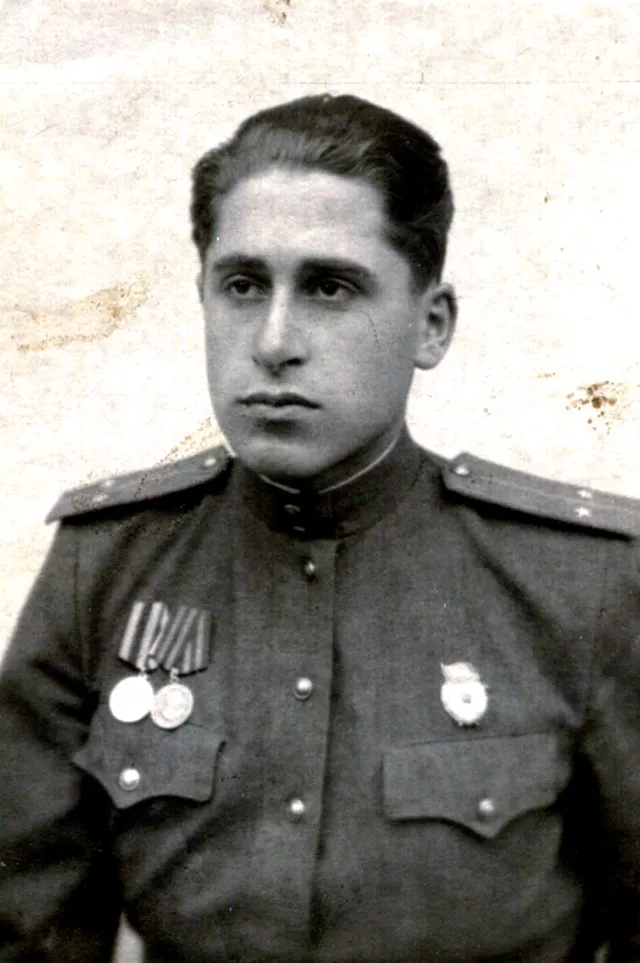Henrich Kurizkes
This is me when I was lieutenant of the Estonian Corps. This photo was taken in Latvia in 1945.
In June 1942 I finished 10th grade and received the school certificate. In the summer I worked in haymaking in the kolkhoz, and in September 1942 I was recruited to the army. My father was recruited a year later, but he was sent to the front before me. He was a driver for the medical battalion of the Estonian Corps. I was sent to a reserve regiment where we were trained in military operations. The regiment was deployed near Kamyshov in the Ural.
We started making earth huts, cutting wood and carrying it to the construction site. We had wagons, but no horses and we pulled those wagons loaded with logs. We had to pull it uphill and one day some big boss visited the regiment and, seeing us, said that people were not horses and were not supposed to drag wagons. As a result, we had to carry the logs on our shoulders instead.
We had eight hours? training each day. We were trained in shooting, disassembling and stripping weapons, crawl and running. We did our best knowing that perhaps our life was at stake at the front and everything depended on our skills. In fall 1943 we were sent from there to the infantry at the front. Our front line life started near Leningrad in siege. These were our first battles. Then we headed to Estonia. We were on our way to liberate our fatherland from the fascists.
In February 1944 the crossing of the Narva began. There were violent battles for the Narva. There were Estonian SS military personnel in the Narva and they had nowhere to retreat. The German commanders convinced them that they were sending assistance soon and they were to hold defense until new forces joined them. And they staged a holdout of this plan. Another desperate thing about these battles was that Estonians fought Estonians, the Estonian Corps of the Soviet army against the Estonian SS division. There were cases when members of one family were on opposite sides. The river was frozen, but the ice was scarlet with blood. In summer 1944 we managed to destroy the enemy fortifications on the bank of the river.
There were many more battles after the Narva. We were marching across the territory of Estonia, from the south of Estonia via Tallinn heading to the islands. The Germans must have envisaged that the end was approaching and were hurriedly running away from Estonia. In early 1945 I was sent on a course for junior command staff. After finishing this training I was awarded the rank of junior lieutenant. When we were sent to Kurland I had a platoon under my command. The final combat actions in Kurland were the most violent. Our command was in a hurry to wrest the ground from the enemy and finish the war, while German forces were holding the lines and fighting desperately, supporting some of their units to give them a chance to evacuate.
We fought in Kurland, when we had some period of inactivity. Actually through April 1945 we were only engaged in training. We made earth huts and were having a rest. We knew the war was coming to an end. In early May, Estonian General Lieutenant Lembit Piarn, Corps Commander, visited us. He came from the family of Caucasian Estonians. These families moved to Georgia in the 19th century looking for a better life. We lined up and Piarn told us that in a few days we would receive a signal to begin combat action and we were to prepare ourselves to advance 7 kilometers within one and a half hours and wrest the ground from the enemy.
We started preparations and training in aimed shooting on the run and running. Then, on 8th May 1945 in the late afternoon, we were ordered to start the combat action. We started moving to our positions. The tanks were moving along the road and the infantry was following them. It was still light, when all of a sudden the tank column stopped and I saw a Willis car approaching us from the German front line. It stopped and a general came out. He approached the tanks and pronounced loudly: ?That's it, comrades! The war is over!? Later I heard that this was General Panyushkin. He had already visited the Germans and they had signaled their surrender.
It's hard to describe what it was like! We had night tracer bullets: a bullet flies and there is light behind it to see its direction. Everybody started shooting in the air and the sky was flashing. It became as light in the forest as during the day. We were ordered to stay overnight in the forest. The field kitchen arrived shortly afterwards, so we ate and for the first time in a long time we were given 100 milliliters of vodka for dinner. We rested the following day, and there were Germans marching past us into captivity. They had no weapons and we were watching them.





















